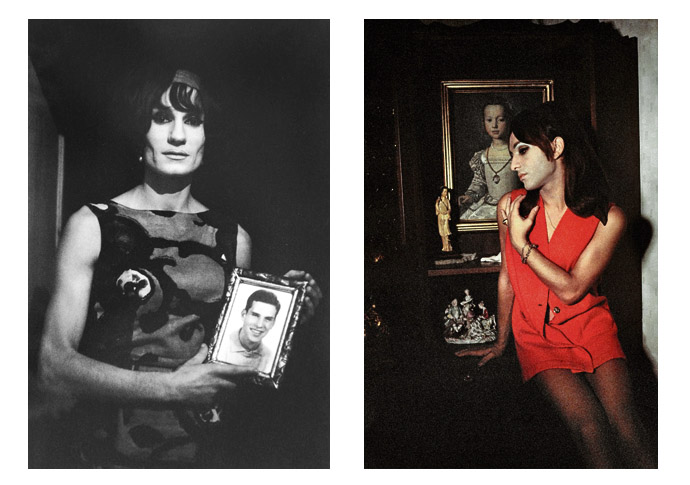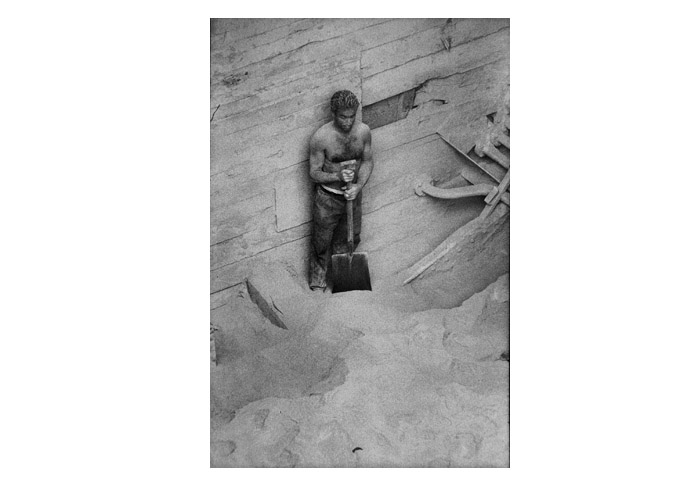Real identities
John Evans on the challenging views of Lisetta Carmi
Thursday, 21st September 2023 — By John Evans

Left: I travestiti, Dalida, Genoa, 1965-6. Right: I travestiti, Audrey, Genoa, 1965-70 [All images © Martini & Ronchetti Courtesy Archivio Lisetta Carmi]
A POIGNANT note is posted by an intimate set of portraits by the Italian photographer Lisetta Carmi in the final show at the Estorick collection in its 25th anniversary year.
It reads: “Throughout this exhibition the title of Lisetta Carmi’s photographic project I travestiti has been left untranslated – the exact English equivalent of the term now being considered outdated.”
Well attitudes can be outdated as well as titles; and they can endure.
As Carmi focused on the trans community of her native Genoa she was, as the experts say, “sensitively chronicling” these lives of the 1960s as part of her wider look at Italian life and culture of that time.
Indeed, in a catalogue foreword, Estorick director Dr Roberta Cremoncini says while Carmi’s images challenged prevailing conventions and were deliberately provocative, “…they were never sensationalist in character, being infused with a profound spirit of empathy and a desire to promote a greater understanding of the world around us”.
This can be seen clearly in the two parts to the show, the I travestiti and a revealing look at conditions for workers in the port of Genoa, at the city’s Italsider steel works, and in Sardinia, with women employed in the island’s cork industry.

Lisetta Carmi, Genoa – Port, 1964
Carmi, who died last year, was born into a middle-class Jewish family in 1924. She was forced to leave school as a consequence of racial laws introduced by the Fascist regime in 1938 and the family fled to Switzerland.
She was a concert pianist but had switched to life as a photographer by 1960.
Her work with the trans community began with a new year’s party and visit to a venue close to the old Jewish quarter in Genoa. She asked permission to picture the people she met and returned with prints the next day.
Images, taken over six years, resulted in the controversial 1972 volume I travestiti. Carmi wrote in the introduction: “I understood that these were human beings who experienced, and suffered deeply from, the contradictions of our society, a minority that was both sought out and rejected.”
Carmi also said her observations ”…made me understand how everything that is masculine can also be feminine, and vice versa. Obligatory behavioural models do not exist outside of an authoritarian tradition that is imposed upon us from childhood”.
The volume was generally ignored. But in 2017 colour slides were found and the project revisited in 2022. The current show features some 30 of the trans community works, both mono and the colour versions rediscovered in the house in Puglia where Carmi retired in 1979 to devote herself to meditation.
To obtain her photographs at the port, Carmi posed as the relative of a docker to capture the harsh conditions. At the steelworks and the cork factory she highlighted the dangers of production and manufacture and these black and white images fill the other main gallery.
Carmi also visited Afghanistan, India, Israel, Mexico, and Venezuela, among other countries.
• Lisetta Carmi: Identities is at the Estorick Collection of Modern Italian Art, Canonbury Square, N1 2AN until December 17. www.estorickcollection.com
Performing again…

Marina Abramović, The House with the Ocean View, 2002, performance; 12 days, Sean Kelly Gallery, New York [Courtesy of the Marina Abramović Archives © Marina Abramović Photo: detail Attilio Maranzano]
SATURDAY sees the opening of a major Royal Academy of Arts retrospective, the first solo such to be given to a woman, with the examination of over five decades’ work by Belgrade-born Marina Abramović.
This show, both for and with the participation of the feted performance art pioneer, includes challenging videos, sculptures, Polaroids, and installations: and seminal pieces that will be reperformed by artists picked and trained for the job by the Marina Abramović Institute.
This week the honorary academician, famous for testing the limits of her own physical and mental pain and endurance, admitted she could no longer “do the stuff I used to do…”
By way of example, there’s a table of 72 objects (a gun, knives, belts, scissors, chains, etc) that she invited an audience to use upon her body, at will, in 1974 as she stood still and silent; then she lost consciousness while lying amid a burning five-pointed star; and in 2010 Abramović would endure days sitting still, and silent again, opposite a vast procession of people who chose to sit opposite.
These events are well illustrated in the show and among the pieces to be revisited will be The House with the Ocean View, 2002, where the artist lived for 12 days in a “home” of three spaces, fasting and drinking only water, again in silence.
It’s strong stuff and the RA notes: “This exhibition contains nudity and art works relating to mortality and the threat of harm”.
• Marina Abramović , in the RA Main Galleries, W1J 0BD, will run September 23 until January 1. www.royalacademy.org.uk
